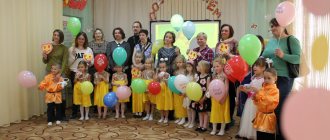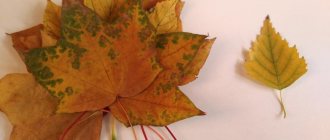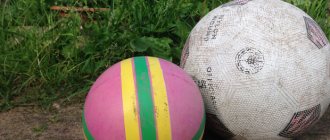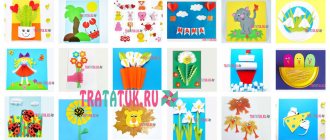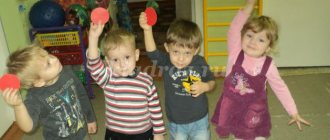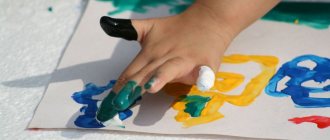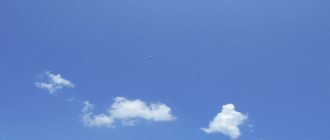Organization and content of observations in preschool educational institutions
Definition 1
Pedagogical observation in kindergarten is one of the methods used by preschool teachers and specialists to collect the necessary information about students.
The purpose of pedagogical observation in a preschool educational institution is to collect information on sensory, communicative, intellectual, creative, etc. development of preschool children.
In the process of pedagogical observation, preschool teachers and specialists not only collect the necessary information, but also note the general dynamics of children’s development. This is necessary in order to timely adjust the educational process and select the most optimal methods and means of raising and teaching preschool children.
Are you an expert in this subject area? We invite you to become the author of the Directory Working Conditions
The importance of pedagogical observation in preschool educational institutions is invaluable, since this method allows the study to cover a sufficiently large number of pupils, conduct research at any convenient time, and helps the researcher “see” the child in his natural environment. During the observation process, the teacher notes the peculiarities of interaction between students, determines the presence of microgroups based on interests, identifies the inclinations and creative needs of children, and much more.
The success of pedagogical observation in a preschool educational institution largely depends on the quality of its organization of the teacher, as well as on his professionalism and ability to organize this type of research. The conclusions obtained and their accuracy depend on the adequacy of the assessment of the child’s behavior and level of development. If the teacher “overlays” his personal attitude towards the child onto the data obtained, then the information obtained during the study will not be reliable and accurate.
Note 1
Thus, pedagogical observation in preschool educational institutions is of great importance for collecting information about the level of development of preschool children, the characteristics of their interaction with each other and identifying their leading creative needs and inclinations.
Finished works on a similar topic
Course work Pedagogical observation in kindergarten 430 ₽ Abstract Pedagogical observation in kindergarten 240 ₽ Test work Pedagogical observation in kindergarten 240 ₽
Receive completed work or specialist advice on your educational project Find out the cost
Observation as the main method of introducing children to nature
The animal is examined according to plan: first the head, then the body, paws, tail. It is necessary to give children a holistic idea of a living creature, emphasizing that it moves, eats, i.e. pay attention to the animal's habits. You can offer one or two kids to feed, say, a rabbit, while paying attention to how it eats.
For the first observation, you should choose an animal that children could not only examine, but also stroke. The attitude that the teacher himself shows towards the animal is very important: his attentiveness and caring is the best example to follow. [14]
Kids get tired quickly, so the teacher should not delay the observation with long explanations. The teacher should summarize the children’s statements with a short, figurative phrase: “The rabbit is white, fluffy, long-eared, jumps deftly, loves carrots.”
Due to the fact that classes conducted with children of primary preschool age are short, and a living object usually arouses great interest and emotional activity in them, when conducting observations there is no need to get carried away with the use of such means as fiction and illustrative material. During the observation process, children’s attention should be focused on the animal, so these tools can only be used at the beginning or end of the lesson.
You can start the lesson with a riddle, a short poem about this animal, and end with showing pictures depicting an animal with cubs or its home or habitat. Children can come up with a nickname for the animal, listen to a song about it, or sing it together with the teacher. This gives completeness to the lesson and at the same time directs the continuation of the conversation about the observed animal.
Thus, when introducing children to the animal world, three educational tasks are solved:
formation
ideas about animals
development
emotional and positive attitude towards them and
upbringing
moral behavior in nature [9]
The next observation is carried out when seedlings appear on the seeds. The teacher suggests comparing dry and sprouted seeds. Pays attention to the color and increase in size of seeds, the appearance of seedlings, etc. Helps establish a connection between the changes that have occurred and the presence of moisture. Invites children to sketch all the changes. Organizes the planting of seeds in the soil and gives the task: to monitor what changes will occur. Subsequent observations are carried out when leaves appear, the formation of an adult plant, the appearance of buds and flowers, and, finally, fruit pods. With each observation, the teacher first draws attention to what changes have occurred. Then helps children connect the changes to ways to care for the plant. To this end, he asks questions: what should I do to make peas grow well? Why do you need to tie up peas? Why loosen the soil (water, weed)? After each observation, the process of growth and development should be sketched. You can make a herbarium. In the final observation, the teacher helps the children reproduce the entire development cycle of peas from seed to new seed. Children are asked to arrange the pictures (drawings) in the order in which the peas grew, and talk about the sequence of changes that occurred. Supervision of observations in different age groups
. Younger groups.
When thinking through the organization and management of children’s observations, the teacher needs to take into account the characteristics of mental processes and the level of cognitive activity of children.
It is known that the attention of young children is attracted by bright, moving objects. Therefore, it is better to organize the first observations of animals rather than plants. At this age, children do not yet know how to keep the goal set for them, accurately follow the plan proposed to them, or summarize the observation. The volume of generated ideas is quite limited. In this regard, at the beginning of observation, the main task of the teacher is to attract the children’s attention to the object. You can use a variety of surprise play techniques: for example, unexpectedly bring an animal to the group or tell the children that rabbits are inviting them to visit, or you can interest the kids with the help of puppet theater characters and funny toys. Then an examination of the object is organized. Considering that children’s attention is primarily attracted by the actions of the animal, the teacher uses various techniques to encourage it to behave actively (feeds the rabbit, plays with a kitten with a paper bow), and then draws the children’s attention to how the animal eats and looks at what sounds it makes. The teacher asks the children questions, encouraging them to name this or that action. In this regard, examination techniques are of great importance. Examining objects helps to identify their sensory attributes. For example, in order for kids to know what kind of fur a kitten has, they are asked to gently stroke it and determine whether it is fluffy or smooth. The teacher also uses imitation of movements and sounds. For example, he invites children to fold their palms and move them like a fish with its tail, meow like a kitten, etc. In the second half of the year, comparison can be used during observations in the younger group. The teacher selects two animals or plants and offers to compare them. You can compare a living object with the image in the picture. The main task of comparison is to establish signs of difference between one object and another. Kids will see that animals and plants differ from each other in size, color, nature of movement, etc. When teaching children, the teacher clearly poses the question, directing their attention to the characteristics being compared, for example: “Look at the sparrow and the dove: which one of them?” more?" or “What color are the feathers of a sparrow and what color are the feathers of a dove?” From the age of three, individual search actions can be included in observation. For example, while feeding the puppy, offer him different food: meat, fish, vegetables - and after observing, ask the children what the puppy likes to eat most. It is important that during observation children behave freely, naturally, so that they can show their attitude towards animals and plants. Much here depends on the adult. When the teacher gives all children the opportunity to actively act, express themselves freely and express their feelings, children receive great joy from communicating with nature. At the end of the observation, in order to enhance the emotional impression of children from communicating with animals or plants, it is advisable to sing them a song, read a poem related to the topic of observation, or play a game where the corresponding character acts. Observations of animals and plants in younger groups should be carried out repeatedly. It is useful to repeat them both with the whole group and with small subgroups and even individually. It is very good if observations are associated with a game, visual activity, for example: “Let's look at the Christmas tree, and then draw it” or “Let's see if we need to wipe off the leaves of the ficus.” Middle group.
Pupils in the middle group already have some stock of specific ideas about nature.
Looking at surrounding objects, they are able to perceive them in detail. However, independent observation at this age is still imperfect. Children cannot identify characteristic features of difference or see common features in several objects. Pupils in the middle group gradually learn to accept the observation task set by the teacher. And if this task coincides with practical activity, then it is perceived quite easily, for example: “The hamster will live with us, we will learn to care for it.” During observation, children listen to the teacher’s questions and, following the plan given by him, examine the object. As a result of observation, with targeted guidance, each of them can create a holistic image of the observed object and give its verbal description. The increased perception capabilities of five-year-old children make it possible to complicate the content of observation. Children are taught to consider not only animals, but also plants, and they can offer both one and two objects at the same time. Now, during observation, each child (or a small group of 2-3 people) receives an object (or several) for individual examination. This is the so-called observation using handouts. Starting from the middle group, long-term observation of the development and growth of animals and plants is organized. The scope of ideas that are formed during observation in the middle group also expands significantly. Children continue to be introduced to the appearance features of some plants and animals, the components and characteristic features of each of them are highlighted. By watching animals, children also learn about how they move, what they eat, and where they live. Gradually, preschoolers begin to understand some connections and relationships between natural objects. On this basis, it becomes possible to develop knowledge about some adaptations of animals and plants to the environment. Observation in the middle group begins with the teacher setting a cognitive task, which often coincides with practical activities, for example: “We will look at a rabbit and learn to care for it,” “Let’s look at a fish and draw it.” During observation, the teacher uses various techniques to help him focus the children’s attention on the appearance features, life manifestations of the animal, and establish the necessary connections and relationships. Questions to children are widely used, which will no longer necessarily be related to the actions of the animal during feeding, playing, etc. Pupils in the middle group are able to hear questions addressed to them and answer them, distracting from the manifestations of animals that are of immediate interest. In addition to questions aimed at clarifying knowledge about the main parts of objects and their features: who is this? What color is the fur? What shape is the body? Etc. - you should ask questions aimed at children establishing elementary connections and relationships between natural objects, so-called search questions, for example: why does the telescope fish swim slowly, and the guppy swim quickly? Why does a hamster climb ladders so deftly? Particular attention should be paid to developing in children the ability to talk about the results of observation. To this end, the teacher thinks through techniques that activate children’s speech: asks the same question in different versions to different children, invites them to pronounce difficult and new words in chorus, choose the most accurate designation of a feature from two or three proposed by the teacher, etc. Children are taught to compare objects based on differences and similarities. In the middle group, children’s personal experiences also begin to be used. For example, when looking at a kitten with a child, the teacher asks the child to remember what color the kitten lives in their home, what he likes to eat, how he plays, etc. This technique contributes to the emergence of interest in observation, the desire to share experienced impressions, and the formation of generalized ideas about animals. During observation in the middle group, it is recommended to use riddles, songs, nursery rhymes, and poems related to the content of the lesson. The teacher can invite the children to remember the poems they know and read them to their peers. Students in the middle group begin to learn simple ways to care for plants and animals; therefore, during the observation, the teacher can ask them to perform simple labor actions: feed the fish (bird), wash the feeder (drinker), etc. Children need to form a clear idea of the observed object, knowledge of some ways to care for it, and a caring attitude. Therefore, when completing the observation, you should use questions to find out how the children acquired knowledge. Questions need to be formulated in such a way that they are interesting to the children and lead to a generalization of the knowledge gained. For example: “Tell me how we will take care of the rabbit” or “How will you recognize a bullfinch if you see it on the street?” The result of observation can also be the practical activities of children: reflection of the observed object in a drawing, caring for it in a corner of nature. In the middle group, observations of plants are carried out more widely than in the younger group. Examination of plants can be organized during labor: for example, invite children to examine the seeds before planting. In the middle of the year, they begin to organize observations of plants for educational purposes (in the classroom). An example of such an activity would be “Examining and comparing begonia and aloe.” Senior group.
At older preschool age, children are able not only to accept a cognitive task set by an adult, but also to independently set it during a variety of activities: play, work, and visual arts.
Quite often, independent setting of tasks in older preschool age is also associated with cognitive activity and the emergence of questions and contradictions during its course. The surveillance is becoming more and more systematic. Children can themselves outline a simple observation plan (“First, let’s look at what kind of rabbit it is, then what and how it eats, how it moves”) and act in accordance with it. The children's perception becomes more dismembered (differentiated). Under the guidance of the teacher, preschoolers identify in objects characteristics that are characteristic and essential for their entire group. On this basis, it is possible to form a generalization. It is also characteristic of observation that children can examine an object not in isolation, but in the system of its connections with the outside world: place and habitat, adaptation to the environment. Thus, children's knowledge, skills and abilities become more complex. In the older group, the teacher introduces children to new objects that can be observed in the immediate environment, and to those that live in other climatic zones. Children continue to be introduced to the appearance features and lifestyle of animals (movement, nutrition, seasonal adaptations, protection from enemies, growth and development). At the same time, an important task that the teacher solves is to establish connections between the appearance of the animal, its lifestyle and habitat. Observations are also organized using handouts. The formation of more complex knowledge in children of senior preschool age requires the teacher to both complicate the organization’s methodology and conduct observation. The observation begins with setting a cognitive task for the children, for example: “Today we will look at parrots in order to learn how to care for them.” Then the teacher asks the children a variety of questions. Some are quite simple, for example, when should the child find out and distinguish the external signs of an object: who is it? What body parts do birds have? Etc. More complex questions force the child to remember what he saw before: what did we feed the bullfinches? - or compare objects and find signs in them differences and similarities: what is the difference between a parrot and a bullfinch? What do all birds have in common? Search questions aimed at establishing connections and relationships are widely used: why does a parrot have a short, strong, hook-shaped beak? What food can a parrot eat? Why is it easy for a parrot to climbs the walls of the cage? Pupils in the older group are given greater independence in using the methods of observation known to them, determining its plan and summing up the results. The teacher helps children in case of difficulties with questions, uses models that ensure completeness and accuracy of perception, establishes connections and relationships, and leads them to independent conclusions. Children reflect the results of observation in speech and use them in various activities (labor, visual arts, etc.). School preparatory group
. The main tendency in the cognitive activity of children in the seventh year of life is the desire for generalization. This is explained by the fact that the children’s ability to see significant signs in objects and natural phenomena has increased. Observation becomes more independent. The teacher’s task is to form generalized elementary concepts in the process of observation, to lead children to understand increasingly complex patterns that exist in nature, and to foster independence. When organizing observations with children of this age, the teacher selects material that contributes to the systematization and generalization of knowledge, helping to see significant signs in objects and natural phenomena. Based on the identification of these essential, general features, children form elementary concepts: “animals”, “plants”, “living”, “non-living”, “winter”, “summer”, etc. The teacher helps students see the general patterns between the environment habitat and appearance of plants and animals, between the conditions of existence and their needs, way of life. Just as in the older group, observation begins with setting a cognitive task for the children. But now, during the lesson, the teacher more often uses a question-task that requires children to be able to observe and systematically report on the results of observation. For example, while observing aquarium fish, the teacher gives the following task: “Look and tell me how a guppy differs from the fish that lived with us before?” He asks additional questions only in case of difficulties, giving the children the opportunity to independently observe the new fish. More often than in the older group, the teacher uses comparisons based on general (similar) characteristics, which makes it possible to guide children to master basic concepts. The teacher strives to ensure that the children’s examination actions are conscious. To this end, survey activities are used to verify impressions obtained during observation. The teacher, with the help of questions, encourages children to understand the method of acquiring knowledge: how did you find out about this? Check it out. Labor activities are widely used to ensure the development of skills and abilities in caring for plants and animals. It’s good if the teacher asks the children riddles, reads poetry, and tells interesting stories, since all this helps to expand the knowledge of preschoolers. A special place among pedagogical methods and techniques is occupied by questions of a search nature. They help children understand the relationship between observed natural phenomena. The observation ends with a generalization.
Structure of pedagogical observation
The organization of pedagogical supervision of a preschool educational institution assumes compliance with the following structure:
- Setting the purpose of observation.
Pedagogical observation must have a clear goal aimed at studying a specific area of children's activity or aspects of the child's personal development. Based on the set goal, the teacher formulates tasks, the gradual solution of which will “lead” to achieving the goal.
- Choosing a situation in which the process of pedagogical observation will take place.
The choice of situation depends on the intended purpose of observation. If the teacher is studying the interaction between pupils, then suitable situations for observation include children playing together, a walk in the area, free activity time, etc. If the purpose of observation is the level of development of the child, then it is more appropriate to observe him in the process of GCD. However, regardless of the goal, in order to obtain the most accurate and complete picture, it is necessary to carry out pedagogical observation of children in all types of activities and record the facts obtained.
- Drawing up a Pedagogical Observation Program.
In order for the information collected during the process of pedagogical observation to be accurate and complete, the research must be carried out systematically and systematically. For this purpose, the teacher develops a Program that includes goals, objectives, observation tools, methods of recording and processing data. The choice of method for recording and subsequent processing of the received information and data depends on the goal and the nature of pedagogical observation. In addition, the Program indicates the time for conducting pedagogical research.
- Direct implementation of pedagogical observation.
During this period, the teacher observes the students and records the information received.
- Processing and interpretation of the results of pedagogical observation.
All obtained results are processed and presented in visual form (diagrams, tables, graphs, etc.). Based on visual data, the teacher formulates conclusions and records them in an observation card (diary). The data obtained is compared with data that was obtained earlier, and appropriate conclusions are also drawn, on the basis of which the teacher can see the dynamics of the child’s development. In the event that the dynamics are insignificant or completely absent, then the educator is faced with the question of the effectiveness of the educational process he organizes.
